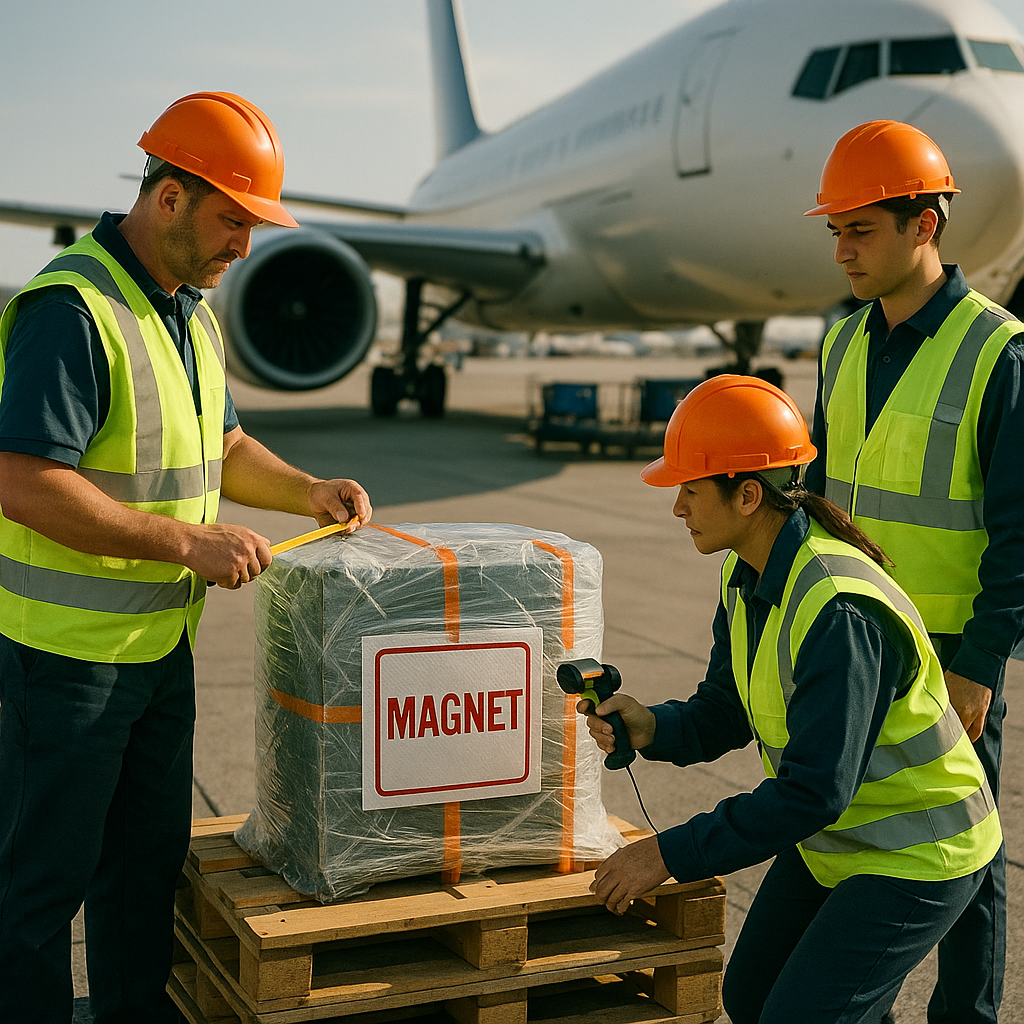5901 Botham Jean Blvd, Dallas, TX 75215
What Are the Challenges of Transporting Large Magnets?
July 23, 2025Large industrial magnets exert forces powerful enough to lift vehicles or pull metal objects from a distance. These remarkable devices create invisible fields that require careful handling during transportation. Their immense power makes relocating them a complex logistical challenge.
The primary concern when transporting large magnets is their powerful magnetic fields. These fields can interfere with sensitive navigation equipment on aircraft and ships, causing compass readings to become unreliable and GPS systems to provide inaccurate data. This interference poses significant safety risks for air transport in particular.
Weight is another major challenge. Large industrial magnets can weigh hundreds or even thousands of pounds and require specialized equipment for loading and unloading. Their brittleness also makes them susceptible to damage if dropped or improperly handled during transit.
How Should Large Magnets Be Packaged for Transport?

Proper packaging is crucial when transporting large magnets to prevent damage and avoid interference with surrounding equipment. Strong magnetic fields can affect electronic devices, navigation systems, and other magnetic materials, necessitating specialized packaging for safe transportation.
Large magnets require careful handling to contain their magnetic fields and protect them from damage. Stronger magnets demand more robust packaging. Here, we explore the most effective methods to package large magnets for transport safely.
Magnetic Shielding Materials
Shielding the magnetic field is the top priority when packaging large magnets. The aim is to confine the magnetic field within the package, preventing external interference.
- Steel-lined boxes: These provide effective magnetic shielding by absorbing and redirecting magnetic field lines within the steel. Thicker steel plates enhance the shielding.
- Iron plates: Placed on all sides of the magnet, iron plates allow magnetic field lines to flow within them, reducing outward extension. High-iron-content plates offer maximum effectiveness.
- Specially designed covers: Some magnets can be transported within custom-designed magnetic shields that completely encase them.
For particularly powerful magnets, multiple layers of shielding material may be necessary. Positioning iron plates at calculated distances around the magnet can enhance field containment for extremely strong magnets that might overwhelm direct contact shielding.
Padding and Cushioning
After shielding, magnets need protection from physical damage during transit. Large magnets are often brittle and can break if subjected to impacts or vibration.
- Foam inserts: Custom-cut foam fitting the magnet’s shape provides excellent protection by preventing movement.
- Bubble wrap: Multiple layers add shock absorption for the packaged magnet.
- Cardboard shredding: Filling empty spaces in the package, this prevents magnet shifting during transit.
- Padding materials: Materials like foam sheets or packing peanuts evenly distribute pressure throughout the package.
For maximum protection, combine multiple cushioning materials to create a multi-layered protective barrier around the shielded magnet.
Arrangement Techniques for Multiple Magnets
When shipping multiple large magnets together, their arrangement is crucial to prevent unwanted interactions.
- Attracting rows with spacers: Arrange magnets in rows where they attract, using non-magnetic spacers to maintain safe separation.
- Individual crating: For very large or powerful magnets, individual crating may be necessary to prevent interaction.
- Non-magnetic dividers: Use sturdy non-magnetic dividers to prevent magnets from contacting each other.
Proper arrangement prevents magnets from snapping together, avoiding damage or injury.
Special Considerations for Air Transport
Air transport entails strict requirements for magnetic materials due to potential interference with aircraft navigation systems.
For air shipping, magnets must be completely shielded to meet IATA Dangerous Goods Regulations. The magnetic field strength must be less than 0.418 A/m (0.00525 Gauss) at a distance of 4.6 meters from any point on the package surface. Packages that don’t meet these standards cannot be flown.
Proper documentation and labeling are also required for air transport, including IATA handling labels for magnetized materials.
When packaging is complete, use a tesla meter to ensure the magnetic field is properly contained before shipping. This step ensures compliance with transportation regulations and prevents shipment rejection.
What Special Considerations Apply to Air Transport of Large Magnets?

Transporting large magnets by air poses challenges as their magnetic fields can interfere with aircraft navigation systems. Despite advancements in GPS technology, the magnetic compass remains vital for navigation. Since Earth’s average magnetic field strength is about 0.5 gauss, even small external magnetic fields can impact compass accuracy.
Large magnets are considered Class 9 Dangerous Goods when shipped by air. International Air Transport Association (IATA) regulations prohibit the air transport of magnets with field strengths above 0.00525 gauss (5.25 milligauss) at 15 feet from the package surface. Many carriers refuse to accept magnets for air shipment because of these risks.
If air shipping is necessary, several stringent requirements must be met:
Magnetic Shielding Requirements
Proper shielding is essential for air transport, often using high-permeability materials like steel or iron to contain the magnetic field. For large magnets, multiple layers of shielding are often needed. The shielding creates a Faraday cage effect that redirects magnetic field lines within the container, preventing external interference.
Testing must confirm that magnetic field strength is less than 5.25 milligauss at 15 feet from the package. If it exceeds 0.00525 gauss at 7 feet, the package requires special Magnetic Material labeling.
Documentation and Certification Requirements
Air shipment of large magnets requires extensive documentation. Shippers must obtain an Air Transport Conditions Identification Report from a qualified appraisal company recognized by civil aviation authorities. This certification process often involves sending samples for testing or arranging on-site inspections.
Certification reports are usually valid only for the current calendar year. This process can be time-consuming and adds significant costs to shipping.
Specialized Packaging Considerations
In addition to magnetic shielding, proper spacing within packaging is crucial. Magnets must be positioned far enough from package edges to avoid attraction to external metal objects during handling and sorting. Arranging multiple magnets with alternating polarities can reduce external field strength compared to single magnets.
Standard envelopes or thin-walled containers are unsuitable for shipping magnets by air since even small magnets can project significant magnetic fields through thin materials.
Cost Implications
The specialized requirements for air shipping large magnets result in substantially higher costs, including:
- Custom shielding materials and specialized packaging
- Magnetic field testing and certification
- Dangerous Goods handling fees from carriers
- Additional documentation and labeling
Due to these complexities and costs, ground transportation is often preferred for shipping large magnets. When air transport is unavoidable, due to time constraints or international shipping needs, it is advisable to work with specialized freight forwarders experienced in handling magnetic materials.
Conclusion: Ensuring Safe and Compliant Transport of Large Magnets

Transporting large magnets involves careful planning and strict adherence to safety protocols. The powerful magnetic fields generated by these devices can pose significant risks to handlers and nearby equipment if not properly managed. It is essential to use proper packaging with suitable shielding materials, such as iron or steel, to contain the magnetic fields and protect the magnets from physical damage during transit.
While ground transportation is generally simpler and involves fewer regulatory hurdles, air transport may sometimes be necessary. In these cases, additional precautions must be taken to comply with stringent aviation regulations, including proper measurement of external magnetic fields and thorough documentation. Note that magnetized materials exceeding specific field strength thresholds are classified as hazardous materials for air shipment and require specialized handling.
For your specific large magnet recycling needs, contact Okon Recycling at 214-717-4083. Our team of experts can provide guidance on best practices to ensure your valuable magnetic materials is recycled safely.
